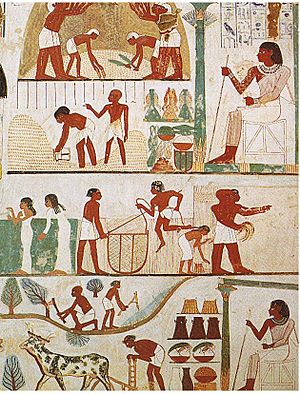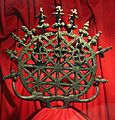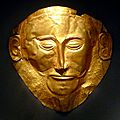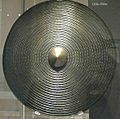Bronze Age facts for kids
The Bronze Age was a time in history when people started making tools and weapons from a special metal mix called bronze. Bronze is usually made by mixing nine parts copper with one part tin. Before this, people mostly used tools made of wood or stone. Bronze was much better for cutting and chopping, and it was also easier to shape into different things.
The Bronze Age didn't start at the same time everywhere in the world. Different groups of people learned how to make and use bronze at different times. For example, in Western Europe, the Bronze Age lasted from about 2000 BC to 800 BC. But in the Middle East, it began much earlier, around 3300 BC in places like Mesopotamia.
Archaeologists believe that societies became more organized during the Bronze Age. Making metal tools was a difficult skill, and the people who knew how to do it became very important. These new metal tools were bought, sold, and traded over long distances.
The Bronze Age eventually ended when people discovered how to make tools from iron. This new period was called the Iron Age. One big reason iron replaced bronze is that tin is much harder to find than iron. Copper tools alone were not very useful because copper is too soft.
Farming and Daily Life
By the Bronze Age, people no longer relied mostly on wild food. Instead, agriculture became the main way to get food. The Sumerians, around 5500 BC, were among the first to develop advanced farming methods.
Farming allowed many more people to live in one area than hunting and gathering ever could. Crops could be stored for later use or traded with others. Because farmers could produce enough food for everyone, some people could focus on other jobs instead of just finding food. This was very important for the rise of full-time armies.
Sumerian farming helped them become powerful, allowing them to win battles and expand their land. This made them early empire builders. Soon after, the Egyptians, who farmed in the very fertile Nile valley, also saw their population grow. They had enough warriors to expand their territory, making their empire much larger than the Sumerian one.
In Sumer, barley was the main crop. They also grew wheat, flax, dates, apples, plums, and grapes. Farming in Mesopotamia depended a lot on the Tigris and Euphrates rivers. Floods from melting snow in the Anatolian mountains would arrive in late spring or early summer.
People also started raising animals. Sheep and goats were domesticated for their meat, milk, butter, and cheese. For example, the large city of Ur kept about 10,000 animals, and 3,000 were used for food each year. Ur had a population of 6,000, with 2,500 people working in farming. They farmed about 3,000 acres of land. These workers included people who kept records, foremen, overseers, and harvest supervisors.
Farmers used teams of oxen to pull light plows without wheels. They harvested grain with sickles. Wagons had solid wheels covered with leather and held in place by copper nails. Oxen pulled these wagons, and sometimes as many as four animals were used for one wagon. Horses were first tamed in Ukraine around 4000 BC and were used by the Sumerians by 2000 BC.
Related pages
Images for kids
-
One of the Alaca Höyük bronze standards from a pre-Hittite tomb dating to the third millennium BC, from the Museum of Anatolian Civilizations, Ankara
-
Hittite bronze tablet from Çorum-Boğazköy dating from 1235 BC, Museum of Anatolian Civilizations, Ankara
-
Sphinx-lion of Thutmose III 1479–1425 BC
-
Late 3rd Millennium BC silver cup from Marvdasht, Fars, with linear-Elamite inscription.
-
Master of Animals in chlorite, Jiroft culture, c. 2500 BC, Bronze Age I, National Museum of Iran
-
Chalcolithic copper mine in Timna Valley, Negev Desert, Israel
-
Spring and Autumn period pu bronze vessel with interlaced dragon design
-
Dancing girl of Mohenjo-daro, c. 2500 BC (replica).
-
Gold 'Mask of Agamemnon' produced during the Mycenaean civilization, from Mycenae, Greece, 1550 BC
-
Nebra sky disc, Germany, 1800-1600 BC
-
Urnfield culture cuirasses, France, 9th century BC.
-
Nuragic figurine, Sardinia, c. 1000 BC
-
Late Bronze Age wine vessel from China.
See also
 In Spanish: Edad del Bronce para niños
In Spanish: Edad del Bronce para niños


























